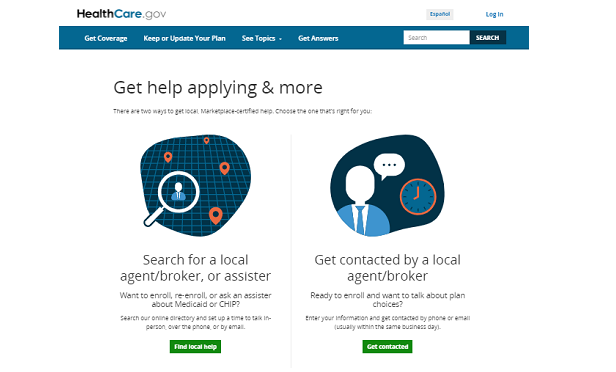
 A screenshot of the HealthCare.gov "find local assistance" page. (Credit: CMS)
A screenshot of the HealthCare.gov "find local assistance" page. (Credit: CMS)
Trump administration regulators want to let states use private web brokers to run their Affordable Care Act (ACA) public health insurance exchange enrollment efforts.
Federal agencies have included that idea in a new set of draft regulations.
If the draft regulations are adopted and implemented as written, a state with a state-based ACA exchange could let one or more outside web brokers handle all exchange plan enrollment activities, instead of running its own health insurance shopping website.
A state that took the state-based, web-brokers-only path would still be responsible for deciding whether consumers were eligible for ACA premium tax credit subsidies.
It also would also be responsible for verifying consumer health insurance application information and meeting all of the statutory and regulatory requirements that apply to state-based ACA exchange programs.
Resources
- A copy of the proposed 2022 Affordable Care Act parameters regulations is available here.
- An article about the draft ACA parameters for 2020 is available here.
The Centers for Medicare and Medicaid Services (CMS) posted the new draft regulations along with its parent, the U.S. Department of Health and Human Services (HHS), and with the U.S. Treasury Department, last week.
The regulations would set parameters for ACA commercial health insurance rules and programs for 2022 health coverage.
Comments on the draft are due Dec. 30.
ACA Exchange History
Former President Barack Obama signed the main part of the ACA into law March 23, 2010. Some parts of the ACA set underwriting and benefits rules for commercial health insurance.
Another part set up the ACA exchange system, in an effort to promote competition in the private health insurance market by providing state-run, web-based health insurance supermarkets.
HHS ended up setting up HealthCare.gov to provide ACA exchange services in states that are unwilling or unable to provide those services.
Some states, including California, Colorado, Connecticut and New York state, operate their own exchange programs.
Officials at HealthCare.gov and Covered California have said that their exchange programs get about half of their users through agents and brokers.
The Politics
It's not clear whether President Donald Trump's contesting of the the Nov. 3 presidential election outcome will have much bearing on how the ACA exchange program would work in 2022.
When the Trump administration came into office, it kept in place most of the ACA exchange program features and rules it inherited from the Obama administration.
Here are five more things to know about the 2022 draft ACA parameters regulations.
1. User Fees
In states where HealthCare.gov provides all exchange enrollment and account administration services, HealthCare.gov charges participating insurers a user fee of 3% of premiums per signup.



